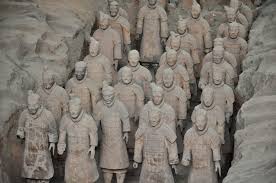
Were the Terracotta Warriors Made by Burning Live People?
The Terracotta Army, an awe-inspiring collection of life-sized terracotta sculptures, stands as a testament to the might and artistry of ancient China. However, a persistent myth claims that these figures were created through a gruesome process involving live people being burned alive. This article aims to debunk this myth and shed light on the true craftsmanship behind these remarkable artifacts.
The Myth of Live Burial
The idea that the Terracotta Army involved live burial likely stems from a misunderstanding of ancient burial practices and a lack of information about terracotta production. The sheer number of figures and their lifelike appearance might lead some to imagine a horrific scenario where individuals were sacrificed.
However, there is absolutely no historical evidence to support this claim. No reputable archaeological findings, ancient texts, or historical accounts mention any such practice being employed in the creation of the Terracotta Army.
The Reality of Terracotta Production
The Terracotta Army is a masterpiece of artistry and craftsmanship, meticulously created by skilled artisans using a complex process involving clay and fire, not human sacrifice.
1. Clay Modeling:
The figures were created using locally sourced clay. Artisans would first sculpt a basic framework, likely using wood or straw. This framework was then layered with clay and molded to create the figures' unique features and details, showcasing remarkable attention to individual hairstyles, armor, and facial expressions.
2. Firing Process:
Once the clay models were complete, they were carefully fired in kilns at high temperatures. The intense heat hardened the clay, turning it into the durable terracotta we see today. The firing process, while essential to creating the figures, leaves no room for the possibility of human sacrifice.
3. Painting and Assembly:
After firing, the figures were meticulously painted with vibrant pigments, adding a layer of realism to their appearance. They were then assembled in their designated formations, showcasing the military ranks and formations of the Qin army.
The Terracotta Army: A Legacy of Artistry, Not Cruelty
The Terracotta Army stands as a testament to the ingenuity and artistic prowess of ancient Chinese artisans. These figures were meticulously crafted to accompany China's first emperor, Qin Shi Huang, in the afterlife. The notion that their creation involved human sacrifice not only lacks any factual basis but also diminishes the remarkable craftsmanship and cultural significance of these artifacts.
FAQs
1. Why do people believe the live burial myth?
The sheer scale and realism of the Terracotta Army, combined with a general lack of knowledge about ancient terracotta production techniques, likely contribute to the persistence of this myth. Sensationalized stories can also spread misinformation.
2. What evidence proves the myth is false?
No archaeological evidence supports the live burial claim. Excavations have not yielded any human remains within the pits housing the Terracotta Army, and no reputable historical accounts mention such practices.
3. What is the significance of the Terracotta Army?
The Terracotta Army provides invaluable insights into the military practices, artistry, and cultural beliefs of the Qin Dynasty. It serves as a powerful symbol of ancient China's imperial past and continues to captivate people worldwide.